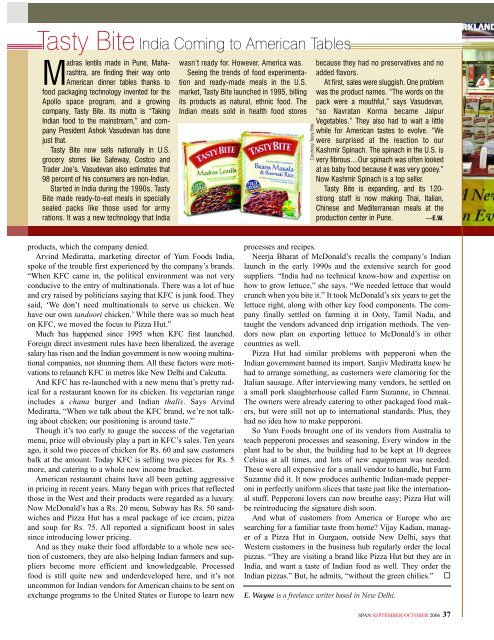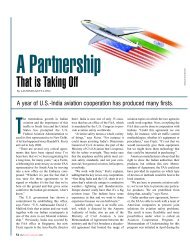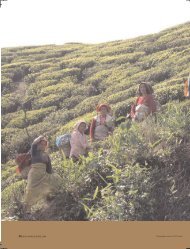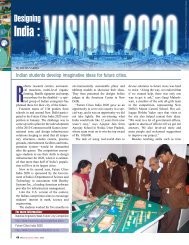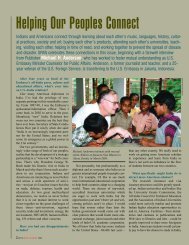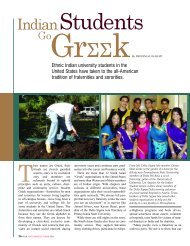Create successful ePaper yourself
Turn your PDF publications into a flip-book with our unique Google optimized e-Paper software.
Tasty Bite India Coming to American Tables<br />
Madras lentils made in Pune, Maharashtra,<br />
are finding <strong>the</strong>ir way <strong>on</strong>to<br />
American dinner tables thanks to<br />
food packaging technology invented for <strong>the</strong><br />
Apollo space program, and a growing<br />
company, Tasty Bite. Its motto is “Taking<br />
Indian food to <strong>the</strong> mainstream,” and company<br />
President Ashok Vasudevan has d<strong>on</strong>e<br />
just that.<br />
Tasty Bite now sells nati<strong>on</strong>ally in U.S.<br />
grocery stores like Safeway, Costco and<br />
Trader Joe’s. Vasudevan also estimates that<br />
98 percent of his c<strong>on</strong>sumers are n<strong>on</strong>-Indian.<br />
Started in India during <strong>the</strong> 1990s, Tasty<br />
Bite made ready-to-eat meals in specially<br />
sealed packs like those used for army<br />
rati<strong>on</strong>s. It was a new technology that India<br />
products, which <strong>the</strong> company denied.<br />
Arvind Mediratta, marketing director of Yum Foods India,<br />
spoke of <strong>the</strong> trouble first experienced by <strong>the</strong> company’s brands.<br />
“When KFC came in, <strong>the</strong> political envir<strong>on</strong>ment was not very<br />
c<strong>on</strong>ducive to <strong>the</strong> entry of multinati<strong>on</strong>als. There was a lot of hue<br />
and cry raised by politicians saying that KFC is junk food. They<br />
said, ‘We d<strong>on</strong>’t need multinati<strong>on</strong>als to serve us chicken. We<br />
have our own tandoori chicken.’ While <strong>the</strong>re was so much heat<br />
<strong>on</strong> KFC, we moved <strong>the</strong> focus to Pizza Hut.”<br />
Much has happened since 1995 when KFC first launched.<br />
Foreign direct investment rules have been liberalized, <strong>the</strong> average<br />
salary has risen and <strong>the</strong> Indian government is now wooing multinati<strong>on</strong>al<br />
companies, not shunning <strong>the</strong>m. All <strong>the</strong>se factors were motivati<strong>on</strong>s<br />
to relaunch KFC in metros like New Delhi and Calcutta.<br />
And KFC has re-launched with a new menu that’s pretty radical<br />
for a restaurant known for its chicken. Its vegetarian range<br />
includes a chana burger and Indian thalis. Says Arvind<br />
Mediratta, “When we talk about <strong>the</strong> KFC brand, we’re not talking<br />
about chicken; our positi<strong>on</strong>ing is around taste.”<br />
Though it’s too early to gauge <strong>the</strong> success of <strong>the</strong> vegetarian<br />
menu, price will obviously play a part in KFC’s sales. Ten years<br />
ago, it sold two pieces of chicken for Rs. 60 and saw customers<br />
balk at <strong>the</strong> amount. Today KFC is selling two pieces for Rs. 5<br />
more, and catering to a whole new income bracket.<br />
American restaurant chains have all been getting aggressive<br />
in pricing in recent years. Many began with prices that reflected<br />
those in <strong>the</strong> West and <strong>the</strong>ir products were regarded as a luxury.<br />
Now McD<strong>on</strong>ald’s has a Rs. 20 menu, Subway has Rs. 50 sandwiches<br />
and Pizza Hut has a meal package of ice cream, pizza<br />
and soup for Rs. 75. All reported a significant boost in sales<br />
since introducing lower pricing.<br />
And as <strong>the</strong>y make <strong>the</strong>ir food affordable to a whole new secti<strong>on</strong><br />
of customers, <strong>the</strong>y are also helping Indian farmers and suppliers<br />
become more efficient and knowledgeable. Processed<br />
food is still quite new and underdeveloped here, and it’s not<br />
uncomm<strong>on</strong> for Indian vendors for American chains to be sent <strong>on</strong><br />
exchange programs to <strong>the</strong> United States or Europe to learn new<br />
wasn’t ready for. However, America was.<br />
Seeing <strong>the</strong> trends of food experimentati<strong>on</strong><br />
and ready-made meals in <strong>the</strong> U.S.<br />
market, Tasty Bite launched in 1995, billing<br />
its products as natural, ethnic food. The<br />
Indian meals sold in health food stores<br />
Courtesy Tasty Bite<br />
because <strong>the</strong>y had no preservatives and no<br />
added flavors.<br />
At first, sales were sluggish. One problem<br />
was <strong>the</strong> product names. “The words <strong>on</strong> <strong>the</strong><br />
pack were a mouthful,” says Vasudevan,<br />
“so Navratan Korma became Jaipur<br />
Vegetables.” They also had to wait a little<br />
while for American tastes to evolve. “We<br />
were surprised at <strong>the</strong> reacti<strong>on</strong> to our<br />
Kashmir Spinach. The spinach in <strong>the</strong> U.S. is<br />
very fibrous....Our spinach was often looked<br />
at as baby food because it was very gooey.”<br />
Now Kashmir Spinach is a top seller.<br />
Tasty Bite is expanding, and its 120str<strong>on</strong>g<br />
staff is now making Thai, Italian,<br />
Chinese and Mediterranean meals at <strong>the</strong><br />
producti<strong>on</strong> center in Pune. —E.W.<br />
processes and recipes.<br />
Neerja Bharat of McD<strong>on</strong>ald’s recalls <strong>the</strong> company’s Indian<br />
launch in <strong>the</strong> early 1990s and <strong>the</strong> extensive search for good<br />
suppliers. “India had no technical know-how and expertise <strong>on</strong><br />
how to grow lettuce,” she says. “We needed lettuce that would<br />
crunch when you bite it.” It took McD<strong>on</strong>ald’s six years to get <strong>the</strong><br />
lettuce right, al<strong>on</strong>g with o<strong>the</strong>r key food comp<strong>on</strong>ents. The company<br />
finally settled <strong>on</strong> farming it in Ooty, Tamil Nadu, and<br />
taught <strong>the</strong> vendors advanced drip irrigati<strong>on</strong> methods. The vendors<br />
now plan <strong>on</strong> exporting lettuce to McD<strong>on</strong>ald’s in o<strong>the</strong>r<br />
countries as well.<br />
Pizza Hut had similar problems with pepper<strong>on</strong>i when <strong>the</strong><br />
Indian government banned its import. Sanjiv Mediratta knew he<br />
had to arrange something, as customers were clamoring for <strong>the</strong><br />
Italian sausage. After interviewing many vendors, he settled <strong>on</strong><br />
a small pork slaughterhouse called Farm Suzanne, in Chennai.<br />
The owners were already catering to o<strong>the</strong>r packaged food makers,<br />
but were still not up to internati<strong>on</strong>al standards. Plus, <strong>the</strong>y<br />
had no idea how to make pepper<strong>on</strong>i.<br />
So Yum Foods brought <strong>on</strong>e of its vendors from Australia to<br />
teach pepper<strong>on</strong>i processes and seas<strong>on</strong>ing. Every window in <strong>the</strong><br />
plant had to be shut, <strong>the</strong> building had to be kept at 10 degrees<br />
Celsius at all times, and lots of new equipment was needed.<br />
These were all expensive for a small vendor to handle, but Farm<br />
Suzanne did it. It now produces au<strong>the</strong>ntic Indian-made pepper<strong>on</strong>i<br />
in perfectly uniform slices that taste just like <strong>the</strong> internati<strong>on</strong>al<br />
stuff. Pepper<strong>on</strong>i lovers can now brea<strong>the</strong> easy; Pizza Hut will<br />
be reintroducing <strong>the</strong> signature dish so<strong>on</strong>.<br />
And what of customers from America or Europe who are<br />
searching for a familiar taste from home? Vijay Kadian, manager<br />
of a Pizza Hut in Gurga<strong>on</strong>, outside New Delhi, says that<br />
Western customers in <strong>the</strong> business hub regularly order <strong>the</strong> local<br />
pizzas. “They are visiting a brand like Pizza Hut but <strong>the</strong>y are in<br />
India, and want a taste of Indian food as well. They order <strong>the</strong><br />
Indian pizzas.” But, he admits, “without <strong>the</strong> green chilies.” �<br />
E. Wayne is a freelance writer based in New Delhi.<br />
<strong>SPAN</strong> SEPTEMBER/OCTOBER 2006 37


